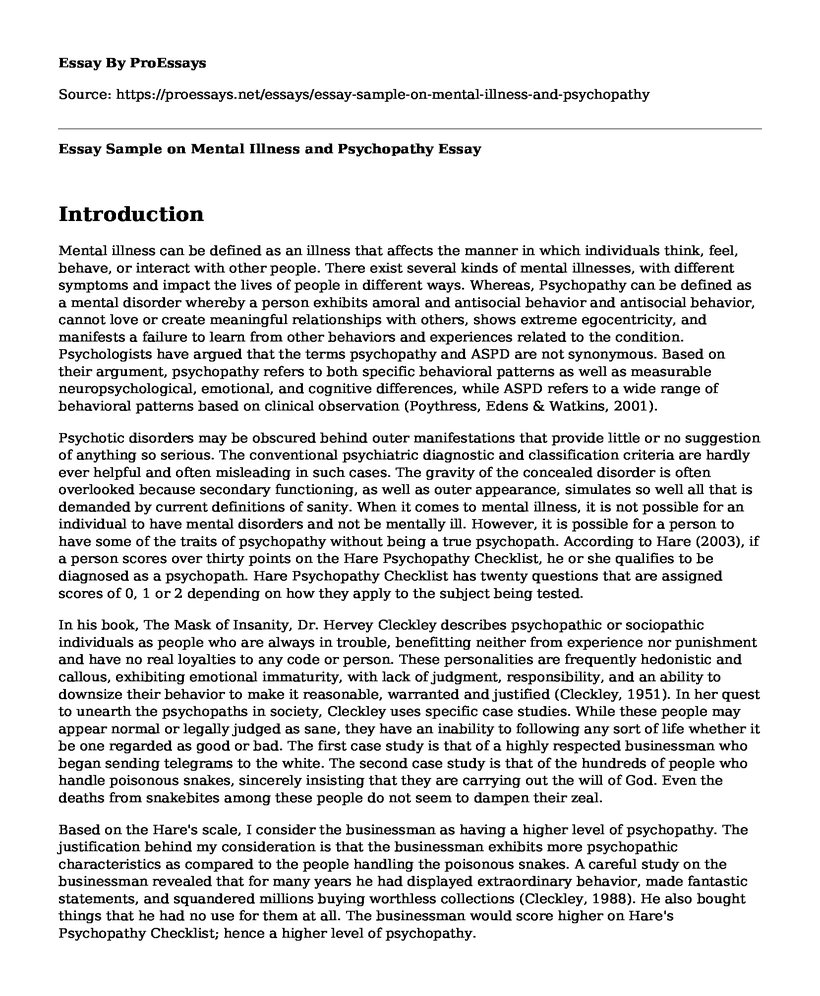Introduction
Mental illness can be defined as an illness that affects the manner in which individuals think, feel, behave, or interact with other people. There exist several kinds of mental illnesses, with different symptoms and impact the lives of people in different ways. Whereas, Psychopathy can be defined as a mental disorder whereby a person exhibits amoral and antisocial behavior and antisocial behavior, cannot love or create meaningful relationships with others, shows extreme egocentricity, and manifests a failure to learn from other behaviors and experiences related to the condition. Psychologists have argued that the terms psychopathy and ASPD are not synonymous. Based on their argument, psychopathy refers to both specific behavioral patterns as well as measurable neuropsychological, emotional, and cognitive differences, while ASPD refers to a wide range of behavioral patterns based on clinical observation (Poythress, Edens & Watkins, 2001).
Psychotic disorders may be obscured behind outer manifestations that provide little or no suggestion of anything so serious. The conventional psychiatric diagnostic and classification criteria are hardly ever helpful and often misleading in such cases. The gravity of the concealed disorder is often overlooked because secondary functioning, as well as outer appearance, simulates so well all that is demanded by current definitions of sanity. When it comes to mental illness, it is not possible for an individual to have mental disorders and not be mentally ill. However, it is possible for a person to have some of the traits of psychopathy without being a true psychopath. According to Hare (2003), if a person scores over thirty points on the Hare Psychopathy Checklist, he or she qualifies to be diagnosed as a psychopath. Hare Psychopathy Checklist has twenty questions that are assigned scores of 0, 1 or 2 depending on how they apply to the subject being tested.
In his book, The Mask of Insanity, Dr. Hervey Cleckley describes psychopathic or sociopathic individuals as people who are always in trouble, benefitting neither from experience nor punishment and have no real loyalties to any code or person. These personalities are frequently hedonistic and callous, exhibiting emotional immaturity, with lack of judgment, responsibility, and an ability to downsize their behavior to make it reasonable, warranted and justified (Cleckley, 1951). In her quest to unearth the psychopaths in society, Cleckley uses specific case studies. While these people may appear normal or legally judged as sane, they have an inability to following any sort of life whether it be one regarded as good or bad. The first case study is that of a highly respected businessman who began sending telegrams to the white. The second case study is that of the hundreds of people who handle poisonous snakes, sincerely insisting that they are carrying out the will of God. Even the deaths from snakebites among these people do not seem to dampen their zeal.
Based on the Hare's scale, I consider the businessman as having a higher level of psychopathy. The justification behind my consideration is that the businessman exhibits more psychopathic characteristics as compared to the people handling the poisonous snakes. A careful study on the businessman revealed that for many years he had displayed extraordinary behavior, made fantastic statements, and squandered millions buying worthless collections (Cleckley, 1988). He also bought things that he had no use for them at all. The businessman would score higher on Hare's Psychopathy Checklist; hence a higher level of psychopathy.
References
Cleckley, H. M. (1951). The mask of sanity. Postgraduate Medicine, 9(3), 193-197.
Cleckley, H. M. (1988). The mask of sanity: An attempt to clarify some issues about the so called psychopathic personality. Aware Journalism.
Hare, R. D. (2003). The psychopathy checklist-Revised. Toronto, ON, 2003.
Poythress, N. G., Edens, J. F., & Watkins, M. M. (2001). The relationship between psychopathic personality features and malingering symptoms of major mental illness. Law and Human Behavior, 25(6), 567-582.
Cite this page
Essay Sample on Mental Illness and Psychopathy. (2022, Dec 12). Retrieved from https://proessays.net/essays/essay-sample-on-mental-illness-and-psychopathy
If you are the original author of this essay and no longer wish to have it published on the ProEssays website, please click below to request its removal:
- Essay Sample on Self-Management and Mindfulness
- Self-Reflection and Creative Counselling Techniques Essay
- Effect of Moisture and Aging on Adhesive Strength Essay
- How Does the Traditional or Cultural Belief Influence the Prevalence of Mental Health in Individuals
- Achieving Self-Efficacy: Vicarious Reinforcement, Emotional Arousal & More - Essay Sample
- Essay on Achieve Well-Being: The Relationship of Psychological & Physical Health
- Free Essay Example on Social Media Addiction: Impact on Mental Health & Habits







